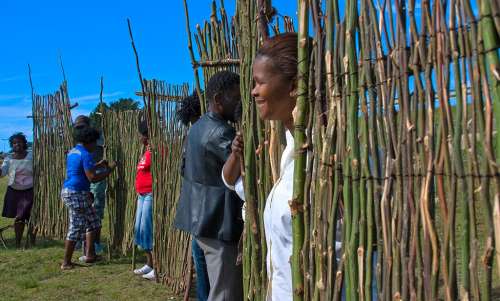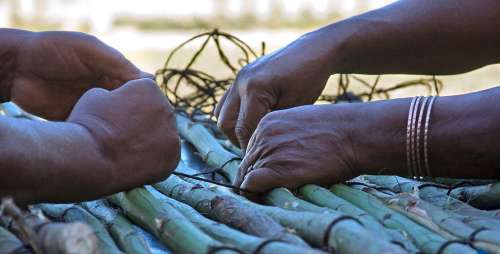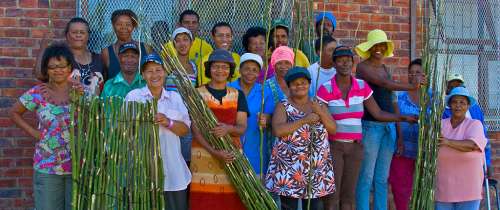Artist-in-Residence : Erica Lüttich
May 2013 • Plettenberg Bay, South Africa
Running Fences
TRANSFORMING A WATTLE SAPLING INTO AN OLIVE BRANCH
compiled by Tanya Pretorius • text & images by Erica Lüttich
- Kurland community members working on their section of Running Fences, Erica Lüttich's three week Site_Specific residency project during May 2013.
Maps show the contours of the land and are criss-crossed by straight lines demarcating boundaries and fences. The lines on maps evoke feelings of barriers and exclusion, and yet simultaneously a sense of invasion and protection. The visual dissecting of land addresses centuries of ownership, spaces of exclusion and inclusion, liberation and war, oppression and loss of ancestral land.
Erica Lüttich was hosted by Joan Berning at Eden to Addo while working on her Running Fences residency project for Site_Specific. Along with various groups and communities in and around Plettenberg Bay, Erica explored these themes during May 2013. The completed fences will be re-erected at the main Site_Specific International Land Art Biennale art event between 10 and 17 August.
Community groups participating were the Pensioners Club in New Horizons, under the guidance of Monica Raubenheimer; the Group of Hope Community based at the Community Centre in Kurland, under guidance of Lien Roman and Amos Lwana and his team; school children from Phakamisani Primary School in Kwanokuthula; Kenneth Magaga and his team from Qolweni; and Derek Wildeman and his team from Harkerville. The Bitou Municipality and the Ebenezer-Ndalo Conservancy helped collecting the wattle that was used to build the fence. Black wattle is a fast-growing and water-hungry invader species that is controlled by physical removal.
By choosing wattle, the Running Fences project engaged skills already present within the Kurland community. Community members know how to identify exotic invader plants, and use black wattle to create products. Group activities such as these focus on sharing and improving skills, and allow for dialogue around a common theme. Visiting artists such as Erica Lüttich set up the opportunity to cross-pollinate on experiences, opinions, knowledge, and techniques.
In communities such as these, there is a deep understanding of the wounds that boundaries have caused. In the practical effort of working together, it is something shared, if not explicitly discussed. Building the physical fence became a metaphorical process for contemplating their impact, and sharing the simple gratitudes of everyday living. Erica Lüttich found the enthusiasm and generosity she encountered, humbling and inspiring.
At the end of three weeks, the various community groups and participants came together to create a Human Fence – each holding their part of the completed fence between them. Over 100 people from Kurland, Qolweni, New Horizons, Kwanokuthula, Harkerville and Kranshoek arrived to share their fences, ideas, and pizza from Skaf'Tin.

Kenneth Magaga with his team from Qolweni hold up their sections of Running Fences at the Human Fence gathering towards the end of Erica Lüttich's three week residency.
HUMAN FENCE GATHERING VIDEO • FACEBOOK EVENT PAGE
About Erica Lüttich
Erica Lüttich is creative director at the Boitumelo Project in Johannesburg. She studied at Ruth Prowse College of Art before becoming a film editor. Since 1985 she has worked with many well-known directors in the Johannesburg film industry and contributed to several international productions. She spent six months in Paris working on a documentary series dealing with Mothers and Daughters in Africa (2003). In 1992 she enrolled at Unisa (BA Fine Arts). This lead to a parallel career as Creative Facilitator-Director within the field of Arts/Craft Community Development. In 2002 she joined the Boitumelo Project in Hillbrow. Her collaborative work with Boitumelo not only addresses past histories but also develops individual creativity, economic empowerment and a sense of self. In 2004 she was the Creative Co-ordinator for the Journey to Freedom project – a collaboration between Unisa and Boitumelo celebrating 10 years of democracy. In addition to her work in the above arenas, Erica also continually produces art in various media including photography, video, installations and sculpture.


